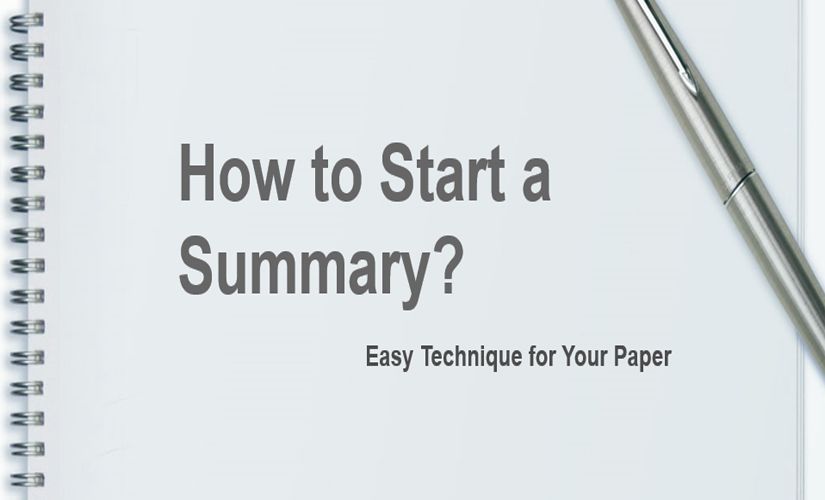When students get assignments to retell specific studies, they ask themselves how to start a summary. Basically, this question arises not only because learners may not have the necessary knowledge but also because they need guides as a starting point. Unfortunately, many summaries must be rewritten because students use irrelevant guides to meet standards. Therefore, this article covers a technique on how to start off a good summary and write a high-quality paper.
General Aspects
Summary writing is a skill that all researchers need to master. Basically, it is one of the types of papers that require students to write in their own words. Moreover, the beginning of summaries is an essential section because a writer needs to understand a source under discussion. In particular, the information on how to make a summary covers its definition, purpose, format, and other guidelines and examples for its subsections, including introductory aspects, general details, and article-specific information.

What Is a Summary and Its Purpose
From its definition, a summary is a brief overview of the main points and essential details of a larger text, speech, or presentation, including stories, scholarly articles, blogs, films, videos, addresses, literature works, poems, plays, books, reports, research papers, essays, PowerPoint slides, conferences, and other types of reading. This type of writing should be written in one’s own words and omits non-essential details, examples, numbers, explanations, and other suggestions, focusing only on the essence of the original content (Provost, 2019). The main purpose of a summary is to shorten complex or lengthy information into a brief and accessible format and provide a quick overview of the texts’ primary concepts and conclusions. For instance, understanding what is a rhetorical analysis essay can be easier with a good summary. After reading the paragraph, all people should understand the core message of the text without needing to engage with the full content (Babin et al., 2018). In turn, such works are useful for reviewing content and preparing for discussions or exams to grasp the main points quickly. Overall, they enhance the accessibility and clarity of information, making it easier for the audience to grasp and remember the main points swiftly (Jeffrey, 2016). As a result, the common 10 types of summary are:
- Abstract: A separate page typically used in academic and research contexts to provide an overview of a study, including its objectives, methods, results, and conclusions.
- Executive Summary: A shortened and overall version of a longer report, research paper, or proposal to highlight the main points, findings, and recommendations.
- Synopsis: A concise paragraph about a book, movie, or play that outlines the main plot points and characters, and it should be done for literature analysis, reviews, or promotional materials.
- Outline: A structured outline that presents the main points in a hierarchical format used to organize information systematically for presentations, essays, or research papers.
- Précis: A concise and clear summary essay on a particular text that maintains the original meaning and structure, following academic writing and rhetorical analysis rules.
- Digest: A summary paper that covers the main ideas and key points taken from a larger text, commonly found in newsletters, journals, or periodicals, to provide readers with essential information quickly.
- Bullet Point: A list of key aspects or main ideas presented in bullet points for quick reference and easy reading of business documents and presentations.
- Annotated Bibliography: A paragraph with additional comments or explanations that provide context or interpretation of the summarized material, such as books, scholarly articles, and other readings.
- Narrative: A descriptive paragraph that provides a detailed recounting of the main events or points in a narrative form used in storytelling or literary analysis.
- Technical Summary: A paper that focuses on the technical aspects and key details of documents, like technical reports and manuals, including specifications, procedures, or methodologies.
Summary Writing Format
A good summary paragraph captures the essence of the original text while choosing all words carefully and providing sentences without grammar, punctuation, formatting, and typo mistakes. Basically, such a work should provide enough information for any reader to understand the main points or ideas of the text without checking the entire work. Hence, the summary writing format must follow:
- Introduction: Start your summary with a brief introduction that provides context for the topic.
- Main Idea: Identify the main message or thesis statement of the original text.
- Key Points: Highlight the most important points or arguments presented in the article.
- Supporting Details: Include key supporting details that contribute to the overall understanding.
- Conciseness: Keep sentences concise and focused, avoiding unnecessary details.
- Order: Organize the points in a logical order to enhance readability.
- Eliminate Redundancy: Remove redundant information while ensuring the core message is covered.
- Critical Information: Emphasize critical information that significantly impacts the main idea.
- Conclusion: Summarize the overall message or conclusion of the original text.
- Word Count: Keep your writing within a specified word count, following any length restrictions.
How to Begin a Summary Paragraph
The first subsection of starting introductory paragraphs contains general details concerning authors, titles, and study topics. When writing an article review, writers should begin by presenting the names and surnames of authors (Babin et al., 2018). In this case, writers must provide names of authors in full forms. If there are multiple authors, instructors should consult students for further directives. Further on, learners must mention titles of articles being summarized. The article’s titles must be written in a format that conforms to chosen referencing rules regarding the inclusion of a source’s title in a text (Babin et al., 2018). Such details inform readers about the necessary information concerning articles. In turn, some examples of good 10 starting sentences and words are:
- From the very beginning, the article “Title” by the author(s) explores the main idea of [theme/topic/subject]… .
- In the book “Title,” the author presents a comprehensive analysis of … .
- Right from the start, the primary focus of the study “Title” conducted by the author(s) is … .
- In “Title,” the author highlights the key aspects of … .
- At the onset, the documentary “Title,” directed by the director(s), sheds light on … .
- To begin with, the report “Title” outlines the crucial findings on … .
- In the essay “Title,” the author discusses the significant points of … .
- To start off, the novel “Title” by the author revolves around the theme of … .
- First and foremost, the research paper “Title” examines the impact of … .
- In the speech “Title,” the Speaker addresses the important issue of … .
How to Write a Body of a Summary
After starting a summary, writing a body involves a systematic process to ensure it is both accurate and concise. In this case, the body should present the major points, such as the main arguments and supporting evidence, in a logical order, reflecting the structure of the original text (Provost, 2019). Being accurate and concise means omitting other minor details, examples, numbers, and any personal opinions, maintaining a neutral and objective tone. Moreover, writers should not include direct quotations unless they are absolutely necessary or instructions require them to use (Provost, 2019). In turn, each key point should be paraphrased in one’s own words because writers must provide a non-plagiarized paper and demonstrate a deep understanding of the material. As such, the body should effectively cover the core content and purpose of the original text in a clear and coherent manner.
How to Conclude a Summary With a Good Sentence
Ending a summary requires a concise and clear closing that underlines the core message of the original text. When students provide background information that places studies into a specific context under discussion, readers need to be aware of general topics of interest (Jeffrey, 2016). Basically, writers have to state research questions immediately after this part. Various important pieces of information covering the technique of how to do a summary are critical because they present specific aspects of general topics, meaning the focus of studies (Younas & Ali, 2021). Moreover, the concluding statement in the first paragraph is the study hypothesis. This sentence should provide much detail on approaches to investigating research questions. Upon completion of this paragraph, readers must have a complete picture of the research scope with a clear understanding of the text’s main contributions and significance (Younas & Ali, 2021). Thus, after highlighting the most significant points without adding any new information, the closing sentence must provide the key ideas with a sense of closure. In turn, some examples of good 10 ending sentences and words are:
- To sum it up, the findings of the study “Title” underline the importance of [theme/topic/subject] … .
- Overall, the director’s “Documentary’s Title” serves as a valid reminder of … .
- Hence, “Title” leaves readers with a profound appreciation for [theme/topic/subject] because the author’s theory provides … .
- Ultimately, the scholarly article contributes significantly to the ongoing discourse surrounding … .
- In his peer-reviewed article “Title,” the author challenges the issue of … .
- In summary, the movie’s compelling narrative and powerful performances of characters make it a must-watch piece because … .
- Finally, the author’s “Title” offers a well-organized synthesis of ideas since … .
- Therefore, “Title” presents a compelling argument for [subject] and challenges readers to rethink their perspectives because of … .
- As such, the article “Title” offers a new perspective on [theme/topic/subject] that encourages other scholars to conduct further analysis of … .
- Thus, the study “Title” leaves readers with a deeper understanding of [theme/topic/subject] and its broader implications because the author argues that … .
10 Easy Steps of How to Start a Summary of an Article
- Find an article needed to be summarized.
- Note the author(s) of this article and its title.
- Read this article.
- Find the main idea of an article.
- Outline key points that support an idea of a discussed article.
- Start a summary with an introductory sentence about an article by mentioning the name and surname of the author (s), including the title.
- Write about the main message in the article made by the author(s).
- Cover supporting points found in the article.
- Include relevant details to the topic used by the author(s).
- Conclude with a final sentence that covers the main idea of the article.
Simple Summary Paragraph Example
The article “How to Start a Summary” by Simon Robbins covers the main rules of writing. In particular, the author states …”Point 1″… . For example, …”Detail 1″… . Then, Robbins argues that …”Point 2″… . In this case, …”Detail 2″… . Further on, the author presents …”Point 3″… . In turn, …”Detail 3″… . As a result, Robbins’ article describes that …”Main Idea”… .
In this case, “Point X” means an idea X made by the author(s), while “Detail X” covers arguments provided by the author(s) to support “Point X.” Besides, “Point X” and “Detail X” can take several sentences. Then, “Main Idea” must include all the points by using from one to two sentences to make a final claim made by the author(s).
Note: Writers must use only ideas presented by the author(s) of the article without adding new concepts or opinions. However, students should not forget that they must use their own words or paraphrase information, explaining what the author(s) intended to deliver to readers (Jeffrey, 2016). Also, the typical word count of a summary is about 100-150 words with a length of about 5-10 sentences, but it may depend on specific instructions.
Article Summary Example
Other Guidelines
Guidelines govern the authorship of the summary example. Firstly, scholars must avoid direct quotations, minimizing their use, because paragraphs should be dominated by paraphrasing. Basically, the essence of writing summaries is to reproduce researchers’ works by using different words (Dormer et al., 2022). It demonstrates writers’s knowledge and writing skills because they need to read and understand sources. Besides, in-text citations accompany direct quotes. Secondly, learners should avoid wordiness and use scientifically accurate language. In turn, eliminating wordy statements enables students to reduce the length of writing.
Word Choice
The choice of words employed by students must maintain the same meaning as original texts to ensure that there are no statements that are characterized by ambiguity. Because the length of summaries is related to purposes, they may be written for different reasons (Busse & August, 2020). In this case, writing purposes dictate the length of the introduction parts and the completed work. Hence, writers must include enough information to meet key rules on how to summarize an article.
Summing Up
In conclusion, correct techniques on how to start writing a good summary have been discussed in much detail. Notably, the nature of the research paper or article review may cause some slight variation from presented structures. Qualitative studies have propositions in place of hypotheses that may modify outlined structures. In turn, the rest of such a structure covers methods, results, discussion, and conclusion, where only critical details are mentioned.
References
Babin, M., Burnell, C., Pesznecker, S. M., Rosevear, N., & Wood, J. R. (2018). The word on college reading and writing. Open Oregon Educational Resources.
Busse, C., & August, E. (2020). How to write and publish a research paper for a peer-reviewed journal. Journal of Cancer Education, 36(5), 909–913. https://doi.org/10.1007/s13187-020-01751-z
Dormer, L., Schindler, T., Williams, L. A., Lobban, D., Khawaja, S., Hunn, A., Ubilla, D. L., Sargeant, I., & Hamoir, A.-M. (2022). A practical ‘how-to’ guide to plain language summaries (PLS) of peer-reviewed scientific publications: Results of a multi-stakeholder initiative utilizing co-creation methodology. Research Involvement and Engagement, 8(1), 1–8. https://doi.org/10.1186/s40900-022-00358-6
Jeffrey, R. (2016). About writing: A guide. Open Oregon Education Resources.
Provost, G. (2019). 100 ways to improve your writing: Proven professional techniques for writing with style and power. Penguin Publishing Group.
Younas, A., & Ali, P. (2021). Five tips for developing useful literature summary tables for writing review articles. Evidence Based Nursing, 24(2), 32–34. https://doi.org/10.1136/ebnurs-2021-103417


